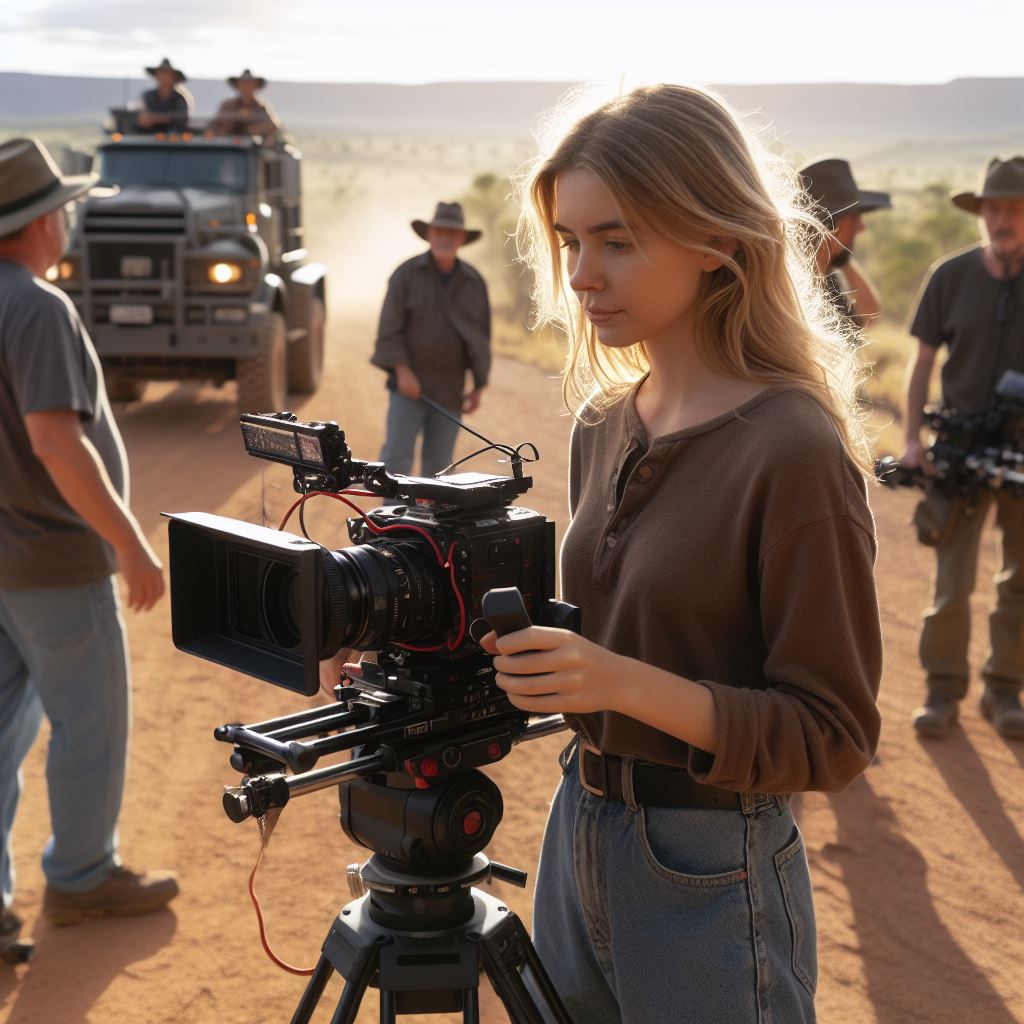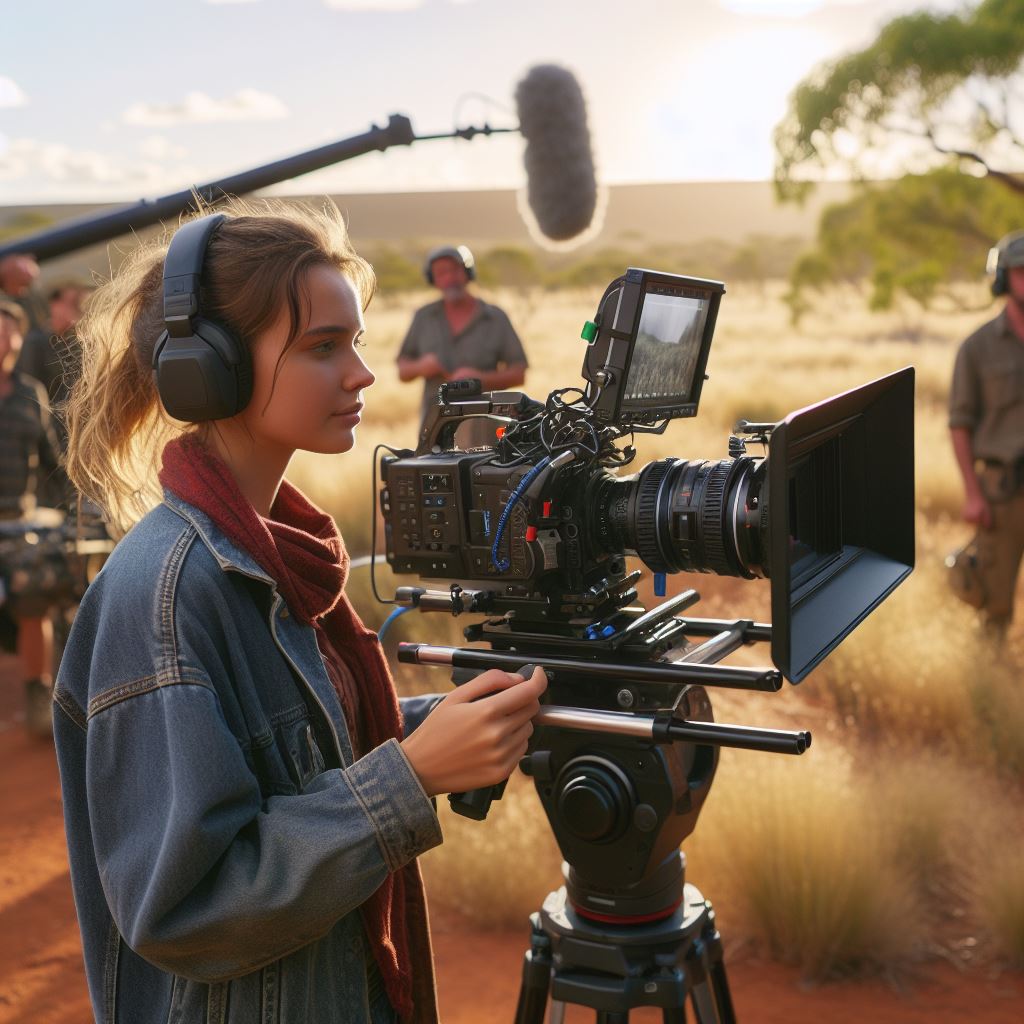Introduction
A day in the life of an Aussie film director offers a glimpse into the demanding yet rewarding world of filmmaking. This role plays a crucial part in the Australian film industry, contributing to its growth and success.
As an Aussie film director, every day is a whirlwind of creativity, responsibility, and collaboration. From the early morning hours, the director is immersed in the process of bringing stories to life on the big screen.
They oversee every aspect of a film’s production, ensuring that their vision is translated into reality.
This role holds immense importance within the Australian film industry. Directors have the power to shape narratives, showcase the country’s unique culture and landscapes, and tell stories that resonate with audiences both locally and internationally.
Their work contributes to the recognition and promotion of Australian filmmaking as a whole.
A typical day for an Aussie film director involves juggling various responsibilities. They may start with script readings, meetings with producers and writers, or scouting locations.
They analyze scripts, plan shots, and collaborate with cinematographers, editors, and actors to bring their vision to the screen. Their attention to detail and ability to work under pressure are critical in creating a successful film.
Additionally, directors play a pivotal role in fostering innovation and creativity in the Australian film industry. Their unique perspectives and storytelling techniques push boundaries and inspire emerging filmmakers.
They serve as mentors and leaders in a constantly evolving industry, encouraging experimentation and diversity.
In essence, a day in the life of an Aussie film director showcases the significance of their role in the Australian film industry. Their contributions not only shape films but also influence the cultural landscape of the country.
Their dedication and passion drive the growth and success of Australian filmmaking, making them an integral part of the industry’s narrative.
Background of the film industry in Australia
Australian films have made a significant impact on the international cinema scene, showcasing the talent and creativity of Australian filmmakers.
Now let’s delve deeper into the intricate details of the Australian film industry.
Thriving and Dynamic Sector
The Australian film industry is an artistic realm where creativity knows no bounds. It has evolved from humble beginnings to become a flourishing industry.
From silent films to contemporary masterpieces, Australian filmmakers have captivated audiences with their unique storytelling techniques.
The Growth and Recognition
The Australian film industry has experienced exponential growth and garnered commendable recognition globally.
Originally, Australian cinema focused on producing films that catered primarily to the domestic audience. However, with the passage of time, filmmakers realized the potential of their craft on the world stage.
This realization led to an increase in international productions being filmed in Australia, further bolstering the industry’s growth and recognition.
Furthermore, government support and funding for the arts have played a vital role in nurturing the film industry, resulting in a diverse range of films being produced.
Significance of Australian Films
Australian films hold immense significance in the international cinema scene, offering a fresh and unique perspective.
Your Personalized Career Strategy
Unlock your potential with tailored career consulting. Get clear, actionable steps designed for your success. Start now!
Get StartedThey provide an alternative to the dominant Hollywood productions, showcasing the rich cultural heritage and distinct storytelling techniques of Australia.
Australian films, often characterized by their realism and rawness, have managed to stimulate global interest and captivate audiences worldwide.
Moreover, these films have given a platform to Australian actors, directors, and crew members, allowing them to showcase their talent on a global scale.
The Australian film industry has come a long way and continues to thrive, contributing significantly to the country’s cultural landscape.
With its diverse range of films and unique storytelling techniques, Australian cinema has carved a niche for itself in the international arena.
It provides a refreshing perspective and serves as a testament to the talent and creativity of Australian filmmakers.
As the industry continues to grow, we can expect more exceptional films that will leave a lasting impact on audiences worldwide.
Qualifications and Skills Required to Become a Film Director
When it comes to pursuing a career as a film director, there are certain qualifications and skills that are necessary for success.
This blog section will discuss the educational background and training required, as well as the creative and technical skills needed for the role. Additionally, we will highlight the importance of networking and industry connections for aspiring directors.
Educational Background and Training
- An aspiring film director typically needs to obtain a bachelor’s degree in film or a related field.
- This educational background provides a solid foundation in film theory, history, and technical skills.
- Many film schools offer specialized programs for aspiring directors, providing hands-on training and mentorship opportunities.
- Attending workshops, seminars, and industry conferences can further enhance a director’s knowledge and skills.
- Obtaining practical experience through internships or working on student films is also highly beneficial.
Creative and Technical Skills
- One of the most important skills for a film director is having a strong visual and storytelling ability.
- Directors must have a keen eye for composition, cinematography, and understanding of visual aesthetics.
- Excellent communication skills are essential for effectively conveying ideas and collaborating with the cast and crew.
- Directors should have a deep understanding of script analysis and the ability to bring characters to life.
- Proficiency in post-production processes, such as editing and color grading, is also crucial for a director.
Networking and Industry Connections
- Building a network of contacts within the film industry is vital for aspiring directors.
- Attending industry events, film festivals, and joining professional organizations can help establish connections.
- Maintaining relationships with actors, producers, and other industry professionals can lead to future collaboration.
- Assisting established directors or working on film sets in various roles can also provide valuable networking opportunities.
- Networking allows directors to gain exposure, learn from experienced professionals, and potentially secure funding for their projects.
In general, becoming a successful film director requires a combination of educational background, training, creative skills, technical expertise, and networking.
While formal education can provide the necessary knowledge, it is important to continuously learn and improve through practical experience and industry connections.
By honing their craft and building a strong network, aspiring directors can increase their chances of achieving their dreams in the highly competitive film industry.
Pre-production phase
The initial stages of a film project
The pre-production phase is where the foundation for a film is laid. It involves various key stages that set the tone and direction for the entire project.
The director’s involvement in script development, casting, and location scouting.
The director plays a crucial role in script development by working closely with the screenwriter to shape the story and create a compelling narrative.
They provide creative input, offer feedback, and make necessary revisions to ensure the script aligns with their vision.
When it comes to casting, the director works in collaboration with the casting director to select the actors who will bring the characters to life.
This process involves auditions, screen tests, and callbacks, where the director evaluates the performances and makes final casting decisions.
Location scouting is another important task undertaken by the director. They work closely with the production designer and location manager to find suitable settings that enhance the story.
The director considers factors such as aesthetics, practicality, and budget while scouting for locations.
Collaborative nature of pre-production and the director’s role in communicating their vision to the team.
Pre-production is a highly collaborative phase, with the director acting as the central figure who communicates and guides the team towards realizing their shared vision.
Stand Out with a Resume That Gets Results
Your career is worth more than a generic template. Let us craft a resume and cover letter that showcase your unique strengths and help you secure that dream job.
Get HiredThe director collaborates closely with the cinematographer to establish the visual style and tone of the film.
Through discussions, storyboards, and visual references, they communicate their ideas and preferences for lighting, camera angles, and overall aesthetics.
The production designer works hand in hand with the director to create the film’s visual world.
The director provides guidance on the production design elements, such as sets, props, and costumes, ensuring they align with the story and contribute to the overall mood and atmosphere.
The director also works closely with the composer or music supervisor to determine the film’s music and sound design. They convey their vision for the desired emotional impact, pacing, and overall sonic experience.
Additionally, the director collaborates with the editor during pre-production, discussing the preferred editing style, pace, and any visual effects that may be required.
This ensures a smooth transition from shooting to post-production, saving time and resources.
Communication is key throughout the pre-production phase. The director holds meetings with the heads of various departments, such as the production designer, cinematographer, and costume designer.
These meetings allow for a seamless flow of information and ideas, ensuring everyone is on the same page.
In summary, the pre-production phase is a crucial time for an Aussie film director. Their involvement in script development, casting, location scouting, and communication with the production team lays the foundation for a successful film.
Through collaboration and effective communication, the director transforms their vision into a collective reality.
Read: Building a Music Career in Australia
Production Phase
During the filming process, the director shoulders several crucial responsibilities to ensure a successful outcome of the movie.
Director’s Responsibilities
- Communicating the vision and creative concept of the film to the cast and crew.
- Working closely with the cinematographer to determine the framing, lighting, and camera movements.
- Providing guidance and feedback to actors regarding their performances and character portrayals.
- Collaborating with the production designer to achieve the desired visual aesthetics.
- Ensuring adherence to the script and making any necessary adjustments during filming.
- Monitoring and directing all aspects of the production to maintain artistic integrity.
Coordination of the Cast and Crew
Another crucial aspect of a film director’s role is managing the extensive cast and crew involved in the production.
- Scheduling and organizing the actors’ availability, taking into account their contracts and other commitments.
- Coordinating with the assistant director to plan and execute the shooting schedule efficiently.
- Assigning tasks to the crew members and ensuring that everyone is aware of their responsibilities.
- Fostering a collaborative environment to enhance productivity and creativity on set.
- Addressing conflicts that may arise among cast or crew members and promoting a harmonious working atmosphere.
Challenges and Problem-Solving
Directors often encounter various challenges during the production phase, requiring them to find effective solutions.
- Unexpected weather conditions can disrupt outdoor shoots, demanding flexibility and adaptability.
- Technical difficulties with equipment or lighting that may hinder the smooth progress of filming.
- Managing time constraints and budget limitations while ensuring the quality of the final product.
- Dealing with unforeseen script changes or improvisations and guiding the cast through these modifications.
- Maintaining a calm and decisive demeanor in high-pressure situations to keep the production on track.
- Collaborating with the film crew to troubleshoot problems and brainstorm innovative ideas.
Generally, the production phase demands immense dedication and diligence from an Aussie film director.
They need to effectively communicate their vision, organize the cast and crew, handle challenges, and creatively problem-solve to ensure the smooth functioning of the set.
Read: Australian Music Awards: A Closer Look

Post-production phase
During the post-production phase, the film director plays a vital role in the editing process. Collaborating closely with editors, sound designers, and composers, the director ensures that the final product achieves the desired narrative and emotional impact.
The director’s involvement in the editing process is crucial in bringing the vision of the film to life. They work closely with the editors to select and arrange shots in a way that creates the desired narrative flow and emotional impact.
Transform Your LinkedIn for Maximum Impact
Elevate your professional brand with a LinkedIn profile that attracts recruiters, showcases your expertise, and maximizes opportunities. Stand out in your industry with a profile built for success.
Boost ProfileBy carefully choosing which shots to include and how to sequence them, the director shapes the story and guides the audience’s experience. Each shot is meticulously evaluated to ensure that it serves a purpose and contributes to the overall storytelling.
The importance of selecting and arranging shots to create the desired narrative and emotional impact.
The selection and arrangement of shots are not only important for the flow of the narrative but also for the emotional impact of the film.
By strategically placing shots, the director can evoke specific emotions from the audience, whether it’s excitement, suspense, or melancholy.
Collaboration with editors is crucial during the editing process. The director and the editor work together to refine the shots, making sure they align with the director’s vision and the overall tone of the film.
This collaborative approach helps in achieving a cohesive final product.
Sound designers and composers also play an essential role in the post-production phase.
The director works closely with them to create the desired auditory experience that complements the visual storytelling. Sound effects and music enhance the emotional impact of the film, adding depth and richness to the storytelling.
The collaboration with editors, sound designers, and composers to achieve the final product.
The collaboration between the director and the sound designers and composers is a delicate balance of communication and creative input.
The director communicates the desired atmosphere and emotions, while the sound designers and composers use their expertise to translate those concepts into sounds and music that enhance the film.
Together, this collaborative effort results in the creation of the final product – a film that not only visually tells a story but also evokes emotions and engages the audience on a deeper level.
Basically, the director’s involvement in the editing process, along with the selection and arrangement of shots, is crucial for creating the desired narrative and emotional impact in a film.
Collaborating closely with editors, sound designers, and composers, the director ensures that the final product captures their vision and resonates with the audience.
The post-production phase is a collaborative endeavor that brings all the elements together to create a powerful cinematic experience.
Read: Music Production: A Guide for Aussies
Gain More Insights: Australian Actor Spotlight: Career Milestones
Challenges and rewards of being a film director
In the fast-paced and creative world of filmmaking, being a film director is both a challenging and rewarding role. Despite the numerous obstacles they face, directors find immense satisfaction and fulfillment in bringing their vision to life on the big screen.
Challenges Faced by Film Directors
- Budget constraints: Obtaining sufficient funding for a film project can be one of the most significant challenges for directors. Limited resources often force them to compromise on certain aspects of production.
- Time limitations: Film directors are constantly under pressure to work within strict deadlines. They must ensure that every scene is shot on time and that the overall project remains on schedule.
- Creative conflicts: Collaborating with a diverse team of actors, writers, producers, and crew members can sometimes lead to creative differences. Directors must navigate these conflicts while staying true to their artistic vision.
- Managing egos: Dealing with actors and other professionals who have strong egos can be challenging. Directors must carefully balance their creative direction while respecting the various individuals involved in the production.
- Rejection and criticism: Film directors often face rejection during the pitching process or when seeking distribution for their films. Additionally, criticism from audiences and critics can be disheartening and challenging to overcome.
Satisfaction and Fulfillment in Film Directing
Despite the challenges, the rewards of being a film director are tremendous:
- Seeing the project come to life: The ability to witness a story take shape, from the script to the final cut, is deeply fulfilling. Watching the actors breathe life into their characters brings a sense of accomplishment.
- Expressing creativity: Film directors have an unparalleled opportunity to express their creative vision and bring their unique ideas to the forefront. They can shape the story, visuals, and aesthetics of the film.
- Impacting viewers: Successful films have the power to touch audiences emotionally, provoke thought, or inspire change. The ability to connect with viewers through storytelling can be immensely rewarding.
- Collaboration and teamwork: The film industry thrives on collaboration, offering directors the chance to work with talented individuals from various disciplines, such as cinematographers, designers, and composers. This collaborative process can lead to profound professional and personal growth.
Accomplishment and Recognition
When a film resonates with audiences and achieves success, it brings a tremendous sense of accomplishment to the director:
- Box office success: A commercially successful film not only brings financial rewards but also indicates that the director’s vision has connected with a wide audience.
- Critical acclaim: Positive reviews from critics and industry professionals validate a director’s work, showcasing their talent, skill, and ability to create impactful storytelling.
- Awards and recognition: Nominations and awards, such as the prestigious Academy Awards, build a director’s reputation and offer professional validation for their creative achievements.
Overall, while film directors face significant challenges in terms of budget, time, creative conflicts, ego management, rejection, and criticism.
The satisfaction and fulfillment they experience from witnessing their projects come to life, expressing their creativity, impacting viewers, and receiving recognition make it a highly rewarding profession.
Read: How to Network in Australia’s Music Scene
Gain More Insights: Cultural Representation: Aussie Actors’ Role
Delve into the Subject: Aussie Music Trends: What’s Hot Now?
Conclusion
In closing, a typical day in the life of an Aussie film director is filled with intense creativity, collaboration, and dedication.
They play a vital role in shaping the Australian film industry by bringing unique stories to life and showcasing the country’s talent and culture.
Aspiring filmmakers should be encouraged to pursue their passion and work towards becoming successful directors, as they have the power to make a significant impact on the film industry.
With hard work, determination, and a love for storytelling, aspiring filmmakers can follow in the footsteps of these inspiring Aussie film directors and contribute to the ever-evolving world of cinema.




